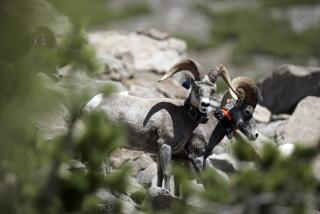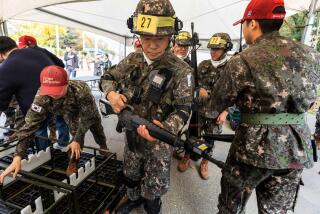Army Trainers to Become Fighters in Iraq
- Share via
FT. IRWIN, Calif. — The Army calls it “The Box,” a vast battleground in the heart of the inhospitable desert dotted with dusty villages marked up in Arabic graffiti declaring, “Saddam Hussein, the Great Arab.”
But this desert is the Mojave, not the Iraqi. And it is where Army ground troops come to get a glimpse of future assignments in the Middle East.
For years, The Box has been a stage for the Army’s elite “opposition force” — soldiers expert at assuming the roles of enemy fighters, be they the Taliban or Iraqi insurgents. Their mission is to toughen new soldiers with elaborate simulations — staging sniper fire, riots, suicide car bombings and potentially dangerous culture clashes.
Staging such scenes has long been the work of the fabled 11th Armored Cavalry Regiment, or Black Horse Regiment. But starting next month, the 3,500-member unit will begin shipping out to Iraq from the Ft. Irwin National Training Center, near Barstow.
Deployments are nothing new in the Army, of course, but there is a special sense of urgency about dispatching the Black Horse to tackle situations that it has trained roughly 500,000 soldiers to handle since 1994. Now the bombs and bullets they encounter will be all too real.
“No one ever thought the Black Horse would be taken out of the National Training Center; they are just too valuable here,” said Maj. John Clearwater. “But the Army is stretched too thin, and Iraq is a big mission.”
A Storied History
News of the deployment surprised some Black Horse troops, whose families had set down roots in the community while believing they would never be sent into actual combat. It also hurt to learn that they would be replaced for at least a year by a National Guard unit with less than two months’ experience as an opposition training force.But Brig. Gen. Robert W. Cone, Ft. Irwin’s commanding officer, said sending the regiment to Iraq makes sense.
“Is it a real unit or not?” he asked. “It’s real, so they will go and serve, and it will increase their credibility when they return. They are one of the most storied patches in the Army inventory, and now they need to share the burden.”
That well-known shoulder patch consists of a shield, divided diagonally into fields of red and gray, with a rearing black stallion in the center. It has been seen all over the world.
The regiment served in the Philippine jungles in 1901, in Cuba in 1905, and in Mexico with Gen. John J. Pershing in a mission to wipe out Pancho Villa’s army in 1906. It also was in Mexico, on May 5, 1916, that the regiment led the last mounted cavalry charge in U.S. history.
During World War II, the regiment served in France, and in 1966 it deployed to South Vietnam. When the Berlin Wall fell in 1989, it patrolled the East-West German border.
In 1994, the Black Horse, one of the best-trained mechanized forces in the world, set down roots at Ft. Irwin to train battalion and brigade task forces in the basic principles of large-scale Army operations.
Since 9/11, the regiment has been replicating volatile scenarios in mock cities with names such as Wasal and Medina Jabal. It created the situations with the help of intelligence reports from Iraq and Afghanistan as well as terrorist interrogations at Guantanamo Bay, Cuba, officials said.
Capt. Mick Mineni, 36, has played the role of an Iraqi mayor at least 60 times over the last two years. In one recent exercise, the beefy soldier with a buzz cut pretended to be a mayor overseeing a plan to have American soldiers fix a broken water system.
“Unfortunately, a female American major walked into my office, crossed her legs and started shaking her foot. Not a good deal. We were deeply offended,” he recalled. “Before long, rumors of her arrogant behavior spread like wildfire across town. After that, nothing went right for the Americans.”
National Guard soldiers, aided by Iraqi Americans hired for the task, are assuming the training duties once handled by the Black Horse. Like their predecessors, the troops will portray a variety of roles: suspicious mayors, wary villagers in flowing robes, angry insurgents armed for battle.
Many of the exercises are played out in lonely outposts that, at first glance, look for all the world like war-torn Iraqi homesteads.
A closer look reveals that many buildings are plywood facades. Others are metal shipping containers painted to look like mud brick. The illusion is shattered when some villagers start speaking English, sometimes with a Southern drawl.
A Training Shift
Erecting fake villages on training grounds where tank battalions once rumbled — along with dispatching the Black Horse to Iraq — reflects a shift in Army training policies. The Box once served as a battleground for simulated fights between nations, often with the Soviets as the enemy. Now, military officials say, the emphasis is on urban battlefields without front lines or uniforms.“Smash-mouth, regiment-on-regiment battles are not what I’m concerned with right now,” Cone said. “For the next year, I’m stressing low-intensity conflict and cultural awareness.”
Each month, the fort trains 4,000 to 5,000 soldiers from other installations. Among other things, GIs learn to shoot to kill from a convoy barreling along at 50 mph and how to spot an improvised bomb.
But soldiers now must be sensitive diplomats, not just warriors, as they attempt to protect people who might not always want their help. Indeed, next to the Bible, soldiers say the most popular book at Ft. Irwin these days is “Islam for Dummies.”
Capt. Mike Glynn, 30, recalled playing the mayor of a town where U.S. soldiers enthusiastically offered to rebuild a school and pave roads. Villagers, portrayed by Black Horse troops, were elated until the soldiers failed to meet their own deadlines.
Things nose-dived further when, under that scenario, a soldier’s rifle accidentally discharged, killing the mayor’s brother, who was also the son of a sheik.
The sheik demanded $1 million for his loss. The soldiers offered $5,000, triggering street demonstrations by the villagers.
Suddenly, a Black Horse soldier portraying a reporter from CNN ran up and started tossing questions at a captain as the situation spiraled out of control. The lesson: Serving in Iraq even means dealing with the media.
Then there was a scenario involving Capt. Fred Odisho, who was born in Iraq and fled that country with his parents in 1980 for the United States.
“I played the role of a night-shift foreman at a mining operation,” he recalled. “Initially, I was neutral toward the American soldiers.”
It didn’t take long for Odisho to choose sides.
“The troops froze when they saw me and some other Iraqi residents walking toward them on the outskirts of town,” he said. “Then they got scared and started handcuffing people for no apparent reason.
“Eight people were arrested, including a woman who was screaming, ‘I’m pregnant and you killed my baby!’ ” he said. “But two escaped and ran back to town to alert others, who started arming themselves with family rifles. End of scenario.”
War Game
The lessons taught by Capt. Douglas Chimenti have nothing to do with culture.Chimenti has spent the last few years in a drab, cluttered office cobbling together increasingly clever explosive devices out of cellular phones and artillery shells. He attaches them to doorbells and garage doors, or hides them beneath prayer rugs, or inside notebooks or behind wall posters of Osama bin Laden.
“I can rig a cellphone up as a bomb trigger in two minutes,” he said, cradling a small but ominous-looking metal box bristling with electrical wire and toggle switches. “The point is to train soldiers to understand how these things work, and how to avoid getting hurt by them.”
The ability to spot explosives was only part of a war game that unfolded on a recent weekday in a desolate valley shadowed by chiseled mountains. A dozen Black Horse insurgents had taken up positions on a nearby ridgeline days earlier in hopes of attacking a passing convoy with rocket-propelled grenade launchers and .50-caliber machine guns.
Of course, the weaponry used in this and all other “force-on-force” operations fired blanks.
Peering through binoculars from a promontory, Lt. Col. John Isaak said, “We don’t want to destroy their equipment. The plan is to hit them hard and fast, kill a few Americans and then fade back into the rocks.”
Moments later, a convoy rumbled into view. The insurgents opened fire, and though they fired blanks, the sound was deafening, echoing off the canyon walls.
Within 20 minutes, the fighting had ended and the insurgents had escaped, taking up new positions in the mountains.
“It’s really smart to train soldiers to understand the existing enemy and they how work,” Isaak said. “After all, you’re not going to see Al Qaeda members rolling tanks down a battlefield.”
As one of the National Guard troops, Isaak will not deploy to Iraq. Instead, he and other GIs are working with the civilian Iraqi Americans, who add further realism to the village scenarios by speaking Arabic.
But whether the training is conducted by guardsmen or the Black Horse, one thing here remains constant: the imposing, dusty hills and brown canyons of The Box. Ft. Irwin got that nickname because the 1,000-square-mile base is shaped like a square.
It is a harsh but oddly beautiful place, covered in spots with a stubble of mesquite, creosote and yucca. Among its well-known features is a large hump of a rock formation known as the “whale.”
When the U.S. invaded Afghanistan in pursuit of Bin Laden, soldiers navigating the steep ridgelines of the Shahi Kot Valley came across a large, rolling outcropping. American planners called it the whale because it reminded them of their days training at The Box.
More to Read
Sign up for Essential California
The most important California stories and recommendations in your inbox every morning.
You may occasionally receive promotional content from the Los Angeles Times.











